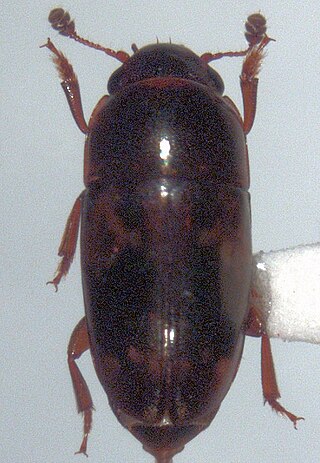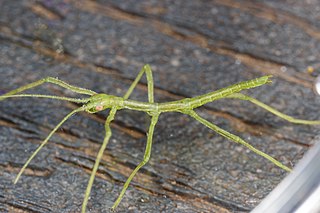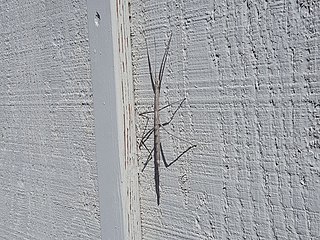
Diapheromerinae is a subfamily of the stick insect family Diapheromeridae. They belong to the superfamily Anareolatae of suborder Verophasmatodea.

Phalacra strigata is a species of moth of the family Drepanidae first described by Brisbane Charles Somerville Warren in 1896. It is found in India, China and Taiwan.
Jacutscia is a monotypic snout moth genus described by George Hampson in 1930. Its single species, Jacutscia strigata, described in the same article, is found in Siberia.

Cryptarcha is a genus of sap beetles, insects in the family Nitidulidae.

Diapheromera arizonensis, the Arizona walkingstick, is a species of walkingstick in the family Diapheromeridae. It is found in North America.

Parabacillus hesperus, the western short-horn walkingstick, is a species of walkingstick in the family Heteronemiidae. It is found in North America. This species is found in dry, arid in the summer and fall. Their diet consists of various scrub and grassland plants. Through an adaptation called "crypsis," it blends in so perfectly with its natural habitat that it often goes completely undetected by would-be predators.

Diapheromera is a genus of stick insects in the family Diapheromeridae. There are about 14 described species in Diapheromera.

Parabacillus is a genus of short-horn walkingsticks in the family Heteronemiidae. There are at least three described species in Parabacillus.

Heteronemiidae is a family of walkingsticks in the order Phasmatodea. There are about 14 genera and at least 80 described species in Heteronemiidae.
Timema ritense, the Santa Rita timema, is a species of walkingstick in the family Timematidae. It is found in North America. The species was originally spelled "ritensis", but this spelling did not match the gender of the genus Timema, and therefore has undergone a mandatory change following ICZN Article 31.2.

Megaphasma denticrus, the giant walkingstick, is a species of phasmid or stick insect in the family Diapheromeridae. It is the largest insect in North America, growing up to 7 inches in length.

Diapheromera velii, the prairie walkingstick, is a species of walkingstick in the family Diapheromeridae. It is found in North America.

Manomera is a genus of walkingsticks in the family Diapheromeridae. There are at least three described species in Manomera.

Pseudosermyle is a genus of walkingsticks in the family Diapheromeridae. There are more than 20 described species in Pseudosermyle.
Cucullia strigata, the streaked hooded owlet or streaky falconer, is a species of moth in the family Noctuidae. It was first described by Smith in 1892 and it is found in North America.
Inscudderia strigata, known generally as the guinea-cypress katydid or striped bush katydid, is a species of phaneropterine katydid in the family Tettigoniidae. It is found in North America.
Centrinogyna is a genus of flower weevils in the beetle family Curculionidae. There are about six described species in Centrinogyna.
Parabacillus coloradus, the Colorado short-horn walkingstick, is a species of walkingstick in the family Heteronemiidae. It is found in North America.

Pseudosermyle catalinae, the Catalina walkingstick, is a species of walkingstick in the family Diapheromeridae. It is found in North America.











